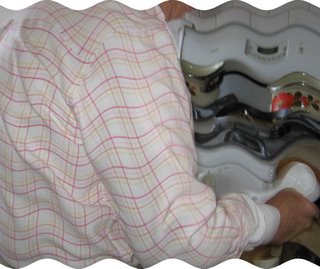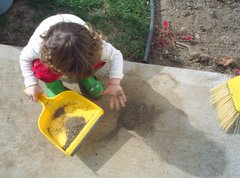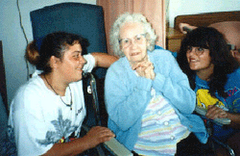Dad grew up a city boy and worked at construction jobs. He bought a small Farmall tractor from the government after WWII to plow, cultivate, and cut grass and hay. Big jobs were his, such as some barnyard work, building and maintaining fence, using the tractor to plow and cultivate, and installing the posts and wires in the grapes. Mother was responsible for the gardening work which brought income for the family when Dad did not have a job.
My first gardening job in the early spring was to tie the grapes when I came home from Catholic grade school. Mother would have already trimmed the grapes to leave only strong vines for new bunches of grapes to grow, or new lower vines to initiate strong vines for the following year. I occasionally helped her cut old clothes and other waste fabric from feed sacks used to sew new clothes. The waste material was used to make 3/4 to 1" wide by 6 to 10' strips that were used to tie grape vines to three wires strung on posts in each row. It was a matter of intertwining a grape vine through the wires, being very careful not to knock off any buds, and using a strip of material to tie each loose vine as upright as possible to the wires.
 1912 Photo of Boys Hoeing
1912 Photo of Boys HoeingHoeing was the most frequent gardening work and it started quite early in the spring. Mother was insistent that weeds were much easier to control if you hoed them when they were small. We learned to use a heavy hoe only when weeds infrequently grew large, such as during a period of constantly rainy weather when hoeing was impossible. Otherwise, an old hoe with a well-worn thin blade was much more productive at cutting the tops of small weeds from the roots. Mother explained that shallow hoeing was preferable to control weeds, with deep hoeing used only when absolutely necessary.
Mother always took a steel file with her to the field to keep our hoes sharpened. Before she used a new hoe and several times afterward, the old hired man of my Grandma would use a hammer and an anvil to pound out the leading edge of the hoe. I remember the loud ring of the hammer on the hoe's cold steel, and I think there is still an anvil in Mother's basement made of an old railroad rail. Only after the hoe's edge was hammered thin would the valuable steel file be used to put a sharp edge on the hoe.
Sharpening a sickle was quite different than sharpening a hoe. The cutting edge of a sickle was used to cut weeds near an obstruction, such as a wall or post. Because a sickle never was supposed to hit anything hard and only cut weeds, its edge was much more important to get absolutely sharp. So a wet stone was used for honing the sharp inside edge of a sickle, rather than the steel file used to sharpen a hoe.
A frost or freeze easily damages strawberry blossoms which was the first crop harvested in the spring (except for rhubarb and asparagus). If frozen, a strawberry blossom develops a black center and no strawberry grows. If Mother said it was going to freeze (and absolute quiet was insisted during the radiio weather forecast), everyone helped cover the strawberries before it got dark. Old quilts, blankets, sofa covers, etc. were used, but newspapers and straw or hay were the primary material used for cover. To keep newspapers from blowing away, a hoe was used to pull dirt around the edges of the newspapers.
Small fragile tomato plants were also protected by newspapers, by making a small hat to cover each plant with a couple of thicknesses of newspaper. In the mid 20th century, the Kansas City Star and Times came twice a day, and they were large, well-read newspapers. If the freeze/frost was not forecast to continue, the cover material was quickly removed the next morning so that the plants could receive warm sunshine.
One year the spring was wet and warm and the strawberries began to easily rot, so Mother recruited all of the family, including Grandma, to help with the picking on an every day basis. Normally, we picked berries every second day--including Sunday. The Church and priests knew that crops were less desirable or could be lost if harvesting was delayed even by a day, so it was considered necessary servile work.
My Dad was home that morning after it had rained the night before and there were a lot of wet strawberries to pick before it became hot. Dad failed to show up in the field and Mother was obviously not happy because the heat combined with the rain would make the strawberries unsuitable for sale. Dad explained that he couldn't stoop to pick berries as easily as his small wife, and he needed to make knee covers so he wouldn't get wet. Mother was clearly frustrated because she was working as fast as she could and it took Dad a long, long time to make those knee covers. He finally showed up in the field with his rubber tire knee covers when Mother and the rest of us were picking the last row. Mother looked at the size of the knee covers and said he would damage the plants with those huge things. I don't remember if Dad picked more than a box of strawberries that day.
I learned that when strawberries and raspberries are picked for sale, the picker carries a 4-legged wooden stand that holds four to six boxes in which to put the berries. The biggest and best berries are saved in one box as another box is filled with the regular run of berries. When the box of smaller berries is almost filled, the saved larger berries are placed on top to make them easier to sell in competition with other growers.
With the berries tat were too small or too ripe, Mother would can as many as 80+ jars of strawberry preserves which she used for breakfast toast, school lunches (strawberry and butter sandwiches were my favorite), and homemade strawberry ice cream. My job was to stem the strawberries so that Mother could cook and can them. I learned to avoid cutting into the strawberry to remove the stem. One time I had to go back to the discarded stems and recut them to remove small pieces of strawberry.
Strawberries are not thorny as are black raspberries, but you can stand while picking raspberries. Standing to pick raspberries is much better than bending over or kneeling in strawberries--take my word for it. When I was ten, we had a very good crop and Mother picked over eight crates of black raspberries in one day. [Each crate held 24 pint boxes.] She was very tired and told me that evening she was so proud of me because I stayed picking to help her. That day, I picked 26 pint boxes of the small berries.
How fast and good a berry picker was my Mother? After I married, I planted a strawberry patch on very good soil where a pig lot had formerly been located. The first crop was of many large berries and Mother came to help me pick. Without telling her, I decided to pick as fast as I could (remember, she was in her mid 50s and I was in my mid 20s) and determine whether I could beat her.
The result was that after I worked as fast as I could to pick two boxes of strawberries, Mother had already picked four boxes and hers were arranged nicer than mine. She explained that when she was quite young, her older siblings made fun of her for picking so slow and called her "slowpoke." Mother told me she was very mad at being called a name and said she practiced picking fast and faster so she could keep up.









No comments:
Post a Comment